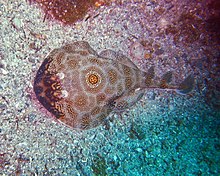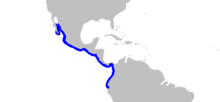Ocellated electric ray
| Ocellated electric ray | |
|---|---|

| |
| Scientific classification | |
| Domain: | Eukaryota |
| Kingdom: | Animalia |
| Phylum: | Chordata |
| Class: | Chondrichthyes |
| Subclass: | Elasmobranchii |
| Superorder: | Batoidea |
| Order: | Torpediniformes |
| Family: | Narcinidae |
| Genus: | Diplobatis |
| Species: | D. ommata
|
| Binomial name | |
| Diplobatis ommata (D. S. Jordan & C. H. Gilbert, 1890)
| |

| |
| Range of the ocellated electric ray[1] | |
| Synonyms | |
|
Discopyge ommata D. S. Jordan & Gilbert, 1890
| |
The ocellated electric ray or bullseye electric ray (Diplobatis ommata) is a
Solitary and
Taxonomy
American
Description
The
The large
The dorsal coloration of the ocellated electric ray is extremely variable, with the only constant being the large ocellus ("eyespot") in the middle of the back. The center of the ocellus is black or yellow, which is surrounded by concentric, alternating dark and light rings that may be either continuous or broken. The remainder of the upper surface is most commonly a shade of light brown with numerous fine dark dots; there may also be light dots, larger dark spots or blotches, and/or irregular brown marbling. Some individuals are plain light or dark brown with a black ocellus. The portion of the disc in front of the eyes is brown with up to five darker blotches. The dorsal pattern often extends to the ventral fin margins; the underside is otherwise white to cream-colored. This species grows up to 25 cm (9.8 in) long.[5][6]
Distribution and habitat
The ocellated electric ray is common in the
Biology and ecology

Like the rest of its family, the ocellated electric ray can defend itself by producing a moderate
Human interactions
The shock from the ocellated electric ray is not dangerous to humans.
References
- ^ . Retrieved 16 November 2021.
- ^ .
- ^ .
- ^ Bigelow, H.B.; Schroeder, W.C. (1948). "New genera and species of batoid fishes". Journal of Marine Research. 7: 543–566.
- ^ a b c d e Fechhelm, J.D.; McEachran, J.D. (1984). "A revision of the electric ray genus Diplobatis with notes on the interrelationships of Narcinidae (Chondrichthyes, Torpediniformes)". Bulletin of the Florida State Museum. 29 (5): 171–209.
- ^ ISBN 1890087572.
- ^ ISBN 0930118189.
- ISBN 0813723183.
- ^ Caira, J.N.; Burge, A.N. (2001). "Three new species of Acanthobothrium (Cestoda: Tetraphyllidea) from the ocellated electric ray, Diplobatis ommata, in the Gulf of California, Mexico". Comparative Parasitology. 68 (1): 52–65.
- ISBN 2914518366.
- ISBN 978-0123849328.
External links
- Photos of Ocellated electric ray on Sealife Collection

